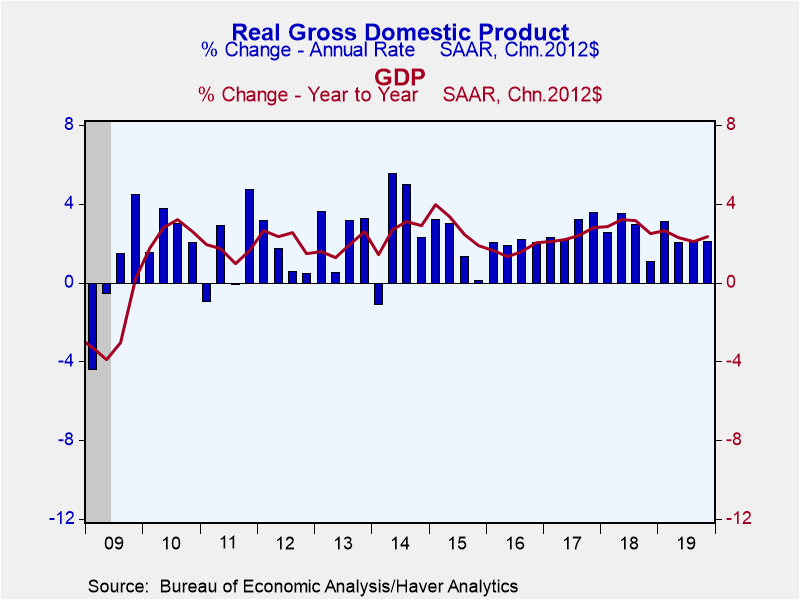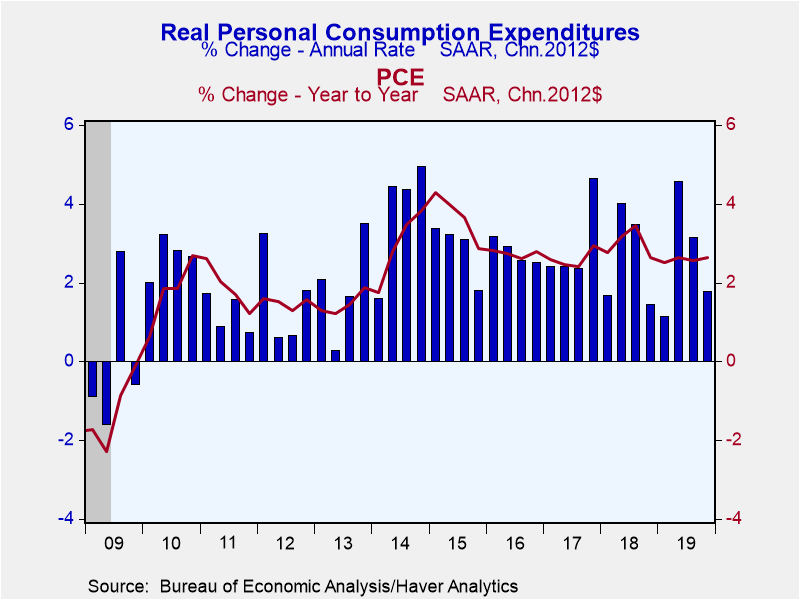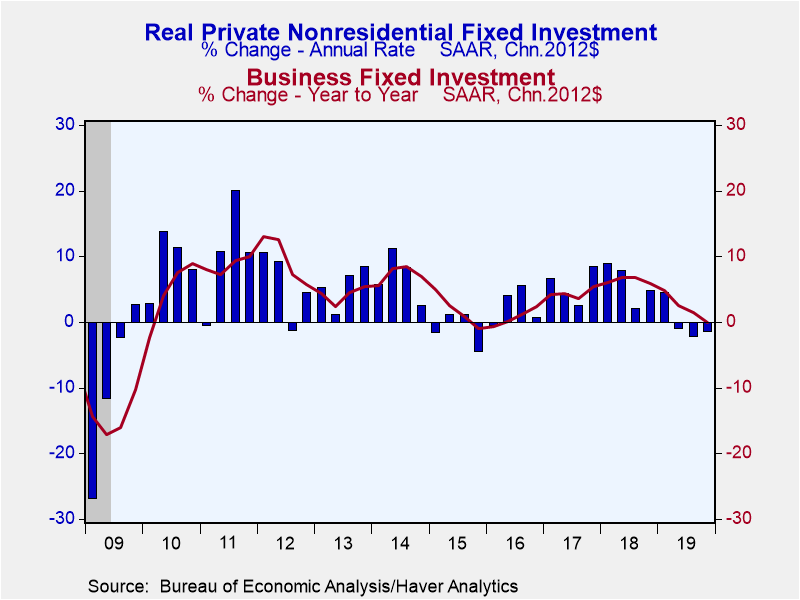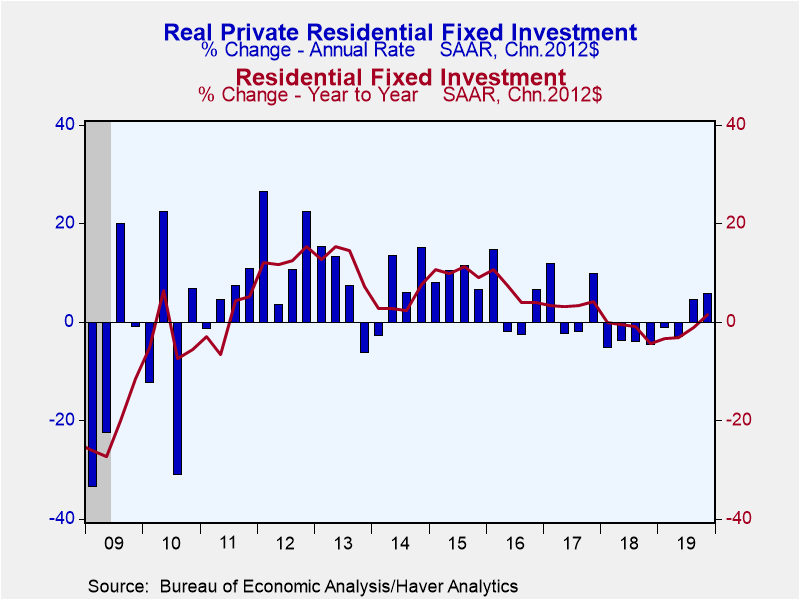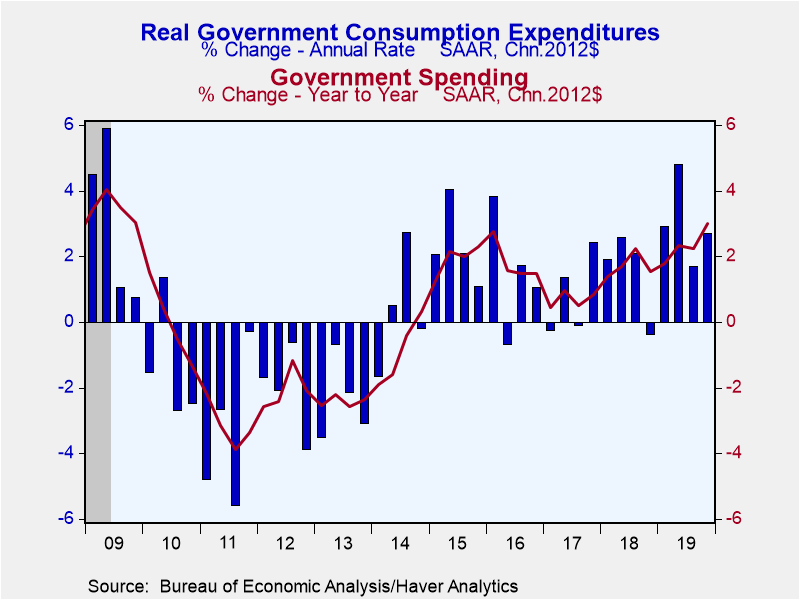 Global| Jan 30 2020
Global| Jan 30 2020U.S. GDP Growth Remains Moderate; Domestic Demand Weakens
by:Tom Moeller
|in:Economy in Brief
Summary
The U.S. economy grew 2.1% (SAAR) during the fourth quarter of 2019. That roughly equaled the growth during the prior two periods and left it at 2.3% for all of 2019. It was the weakest quarterly rate of growth since 2016 and met the [...]
The U.S. economy grew 2.1% (SAAR) during the fourth quarter of 2019. That roughly equaled the growth during the prior two periods and left it at 2.3% for all of 2019. It was the weakest quarterly rate of growth since 2016 and met the expected increase in the Action Economics Forecast Survey.
A weakening of growth in domestic final demand to 1.6% (2.3% y/y) held the economy back. It was the slowest rise since Q4'18 and was down from a 4.9% peak in Q4'17.
The consumer was less inclined to shop. Personal outlays rose 1.8% (2.6% y/y), a sharp deceleration from growth during the prior two quarters. Spending growth on durable goods slowed to 2.1% (5.7% y/y) as motor vehicle buying edged just 0.8% higher (1.9% y/y). Recreational vehicle purchases grew 3.3% (12.5% y/y) after a 17.0% Q3 gain and growth in furniture purchases also decelerated to 3.3% (5.0% y/y). Nondurable goods purchases improved 0.8% (3.3% y/y) following a 3.9% rise, held back by declines in spending on food & beverages and "other" products. Apparel purchases increased 5.8% (3.3% y/y) and gasoline & other energy product purchases rose 4.7% (1.2% y/y). Consumer spending on services increased a weakened 2.0% both q/q and y/y. Outlays on housing & utilities rose just 0.8% (1.0% y/y) and spending growth at restaurants fell to 1.2% (2.0 y/y). Growth also slowed for transportation services to 2.4% (3.7% y/y) but it picked up to 2.8% (2.0% y/y) for recreation. Health care outlays increased a strengthened 2.9% (3.3% y/y).
Business fixed investment remained constrained as it fell 1.5% (-0.1% y/y), down for the third consecutive quarter. The weakness was paced by a 10.1% drop (-7.0% y/y) in building outlays, which was on a par with the declines in three of the prior four quarters. Equipment investment also slackened 2.9% (-1.5% y/y), down for the third quarter in the last four. A sharp 13.2% decline (-2.4% y/y) in industrial equipment buying was accompanied by a 2.1% drop (+1.7% y/y) in information processing gear. Offsetting these declines was a 5.9% rise in intellectual property product investment. Annual growth of 6.2% was, however, below the peak of 9.6% early last year.
Residential investment improved 5.8% (1.5% y/y), the second quarter of strength after falling for the last two years.
Government spending growth also picked up 2.7% q/q leaving y/y growth at 3.0%, its strongest since 2009. Federal government spending rose 3.6% (4.3% y/y) bolstered by a 4.9% strengthening of defense outlays. During all of 2019, defense spending rose 4.9%, the quickest growth in ten years, making up for declines early in the decade. Nondefense outlays rose 4.0% y/y, the quickest y/y growth since 2012. State & local investment also rose an improved 2.2% y/y, up from 0.4% in 2017.
Holding back economic performance was inventory liquidation which subtracted 1.1 percentage points from GDP growth. Offsetting this drag was a 1.5 percentage point addition to growth from a lessened foreign trade deficit. Exports of goods & services rose 1.4% (0.2% y/) while imports declined 8.7% (-2.2% y/y).
Pricing power remained under control as the GDP price index rose a modest 1.4% (1.7% y/y). A 1.8% gain had been expected. The PCE price index rose a fairly steady 1.6%, but prices excluding food & energy were up 1.3%, leaving y/y growth a reduced 1.6%. The business fixed investment price index eased 0.2% while y/y growth slipped to 1.0%. Offsetting these moderations was improved residential investment pricing. The price index rose 2.7% q/q and a steady 2.6% y/y.
The GDP figures can be found in Haver's USECON and USNA database. USNA contains virtually all of the Bureau of Economic Analysis' detail in the national accounts. Both databases include tables of the newly published not seasonally adjusted data. The Action Economics consensus estimates can be found in AS1REPNA.
| Chained 2012 $ (%, AR) | Q4'19 | Q3'19 | Q2'19 | Q4'19 Y/Y | 2019 | 2018 | 2017 |
|---|---|---|---|---|---|---|---|
| Gross Domestic Product | 2.1 | 2.1 | 2.0 | 2.3 | 2.3 | 2.9 | 2.4 |
| Inventory Effect (%-point) | -1.1 | 0.0 | -0.9 | -0.4 | 0.1 | 0.1 | 0.1 |
| Final Sales | 3.2 | 2.1 | 3.0 | 2.7 | 2.2 | 2.8 | 2.3 |
| Foreign Trade Effect (%-point) | 1.5 | -0.1 | -0.7 | 0.4 | -0.1 | -0.2 | -0.2 |
| Domestic Final Sales | 1.6 | 2.2 | 3.6 | 2.3 | 2.3 | 3.0 | 2.5 |
| Personal Consumption Expenditure | 1.8 | 3.1 | 4.6 | 2.6 | 2.6 | 3.0 | 2.6 |
| Nonresidential Fixed Investment | -1.5 | -2.3 | -1.0 | -0.1 | 2.1 | 6.4 | 4.4 |
| Residential Investment | 5.8 | 4.6 | -2.9 | 1.5 | -1.5 | -1.5 | 3.5 |
| Government Spending | 2.7 | 1.7 | 4.8 | 3.0 | 2.3 | 1.7 | 0.7 |
| Chain-Type Price Index | |||||||
| GDP | 1.4 | 1.8 | 2.4 | 1.7 | 1.8 | 2.4 | 1.9 |
| Personal Consumption Expenditure | 1.6 | 1.5 | 2.4 | 1.5 | 1.4 | 2.1 | 1.8 |
| Less Food & Energy | 1.3 | 2.1 | 1.9 | 1.6 | 1.6 | 1.9 | 1.6 |
| Nonresidential Investment | -0.2 | 0.5 | 2.0 | 1.0 | 1.1 | 1.4 | 1.0 |
| Residential Investment | 2.7 | 3.4 | 1.7 | 2.6 | 2.9 | 5.6 | 4.5 |
Tom Moeller
AuthorMore in Author Profile »Prior to joining Haver Analytics in 2000, Mr. Moeller worked as the Economist at Chancellor Capital Management from 1985 to 1999. There, he developed comprehensive economic forecasts and interpreted economic data for equity and fixed income portfolio managers. Also at Chancellor, Mr. Moeller worked as an equity analyst and was responsible for researching and rating companies in the economically sensitive automobile and housing industries for investment in Chancellor’s equity portfolio. Prior to joining Chancellor, Mr. Moeller was an Economist at Citibank from 1979 to 1984. He also analyzed pricing behavior in the metals industry for the Council on Wage and Price Stability in Washington, D.C. In 1999, Mr. Moeller received the award for most accurate forecast from the Forecasters' Club of New York. From 1990 to 1992 he was President of the New York Association for Business Economists. Mr. Moeller earned an M.B.A. in Finance from Fordham University, where he graduated in 1987. He holds a Bachelor of Arts in Economics from George Washington University.


